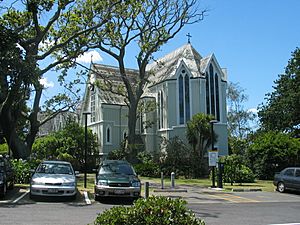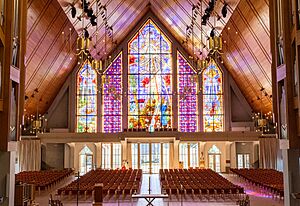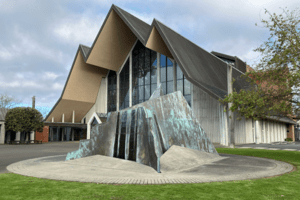Holy Trinity Cathedral, Auckland facts for kids
Quick facts for kids Holy Trinity Cathedral |
|
|---|---|
| Cathedral of the Holy Trinity | |

Holy Trinity Cathedral, Auckland. The main façade hints at features of the elevation of the older wooden cathedral just visible behind it
|
|
| 36°51′35″S 174°47′01″E / 36.8596°S 174.7836°E | |
| Country | New Zealand |
| Denomination | Anglican |
| History | |
| Status | Cathedral |
| Founded | 1957 |
| Founder(s) | Bishop John Simkin |
| Dedication | Holy Trinity |
| Consecrated | 28 October 2017 by Bishop Ross Bay |
| Architecture | |
| Functional status | Active |
| Architect(s) |
|
| Architectural type | Church |
| Years built | 1961 – 1965 |
| Specifications | |
| Capacity | 1,250 parishioners |
| Administration | |
| Parish | Cathedral of the Holy Trinity |
| Diocese | Auckland |
| Province | New Zealand |
The Holy Trinity Cathedral is a very important church in Parnell, a suburb of Auckland, New Zealand. It's an Anglican cathedral, which means it's the main church for the Anglican Diocese of Auckland and where the Bishop of Auckland has their special seat. The main building we see today was officially opened in 1973.
Contents
The Story of the Cathedral
The Holy Trinity Cathedral has a long and interesting history, connected to the very first churches in Auckland.
Auckland's First Churches
St Paul's Church: The Mother Church
The first Anglican church in Auckland was St Paul's. It was started in 1841, just a year after Auckland itself was founded. Because it was the first, it's known as the 'mother church' of the city. The first St Paul's building was in Emily Place, and you can still find a plaque there today marking the spot.
For over 40 years, St Paul's was the main church for the Bishop of New Zealand, Bishop George Selwyn. He was the bishop for 28 years!
St Barnabas' Parish Church: For Māori People
As more European people came to Auckland, there was a lot of pressure on Māori land. To help with this, a second Anglican church, St Barnabas, was opened in 1849. It was built especially for Māori people. The original small church building was later moved to Mount Eden, where it is still part of the St Barnabas' Parish Church today.
St Mary's Church: A Growing Need
In 1860, the first St Mary's Church was built. It stood where the current cathedral is now. However, it quickly became too small and uncomfortable for Auckland's fast-growing population.
So, in 1886, work began on a new, larger church called the Cathedral Church of St Mary. This beautiful wooden church was designed by a famous New Zealand architect named Benjamin Mountfort. It was finished in 1897.
St Mary's Church served as Auckland's main Anglican church until 1973. That's when the new Holy Trinity Cathedral's main part, called the chancel, started being used. In 1982, St Mary's Church was carefully moved across Parnell Road to its current spot right next to the Holy Trinity Cathedral.
The Diocese of Auckland
Today, the Diocese of Auckland is one of seven dioceses (church areas) in the Anglican Church in Aotearoa, New Zealand and Polynesia. This diocese covers a large area, from North Cape down to the Waikato River, and across to the Coromandel Peninsula.
Bishop George Selwyn was a pioneer for the Anglican church in New Zealand. When he arrived in 1841, the whole colony was considered one huge diocese, covering a massive part of the Earth! Bishop Selwyn worked hard to set up the church, and many small chapels, churches, schools, and a special college for training priests were built during his time.
In 1856, Bishop Selwyn created New Zealand's first separate diocese, Christchurch. More dioceses followed soon after: Nelson and Waiapu in 1858, and Wellington in 1859.
In 1843, Bishop Selwyn bought the land in Parnell where the cathedral stands today. He also bought land for St Stephen's Chapel and other church buildings.
When Bishop Selwyn returned to England in 1868, William Cowie became the first bishop officially known as the Bishop of Auckland. This is often seen as the start of the Diocese of Auckland, even though the church's roots go back to 1841.
As the dioceses grew stronger, the building of New Zealand's cathedrals began. In Auckland, it was planned to build a cathedral for 1000 people, but it was too expensive. Instead, they decided to replace the small St Mary's church with a larger one. This new St Mary's church was named a cathedral in 1887, even before it was fully finished.
By 1926, the Auckland diocese was very large. So, the southern parts were separated to form the Diocese of Waikato.
Cathedral Buildings
St Mary's Church
St Mary's Church used to be the main cathedral for the Anglican Diocese of Auckland. It replaced an even older church. This beautiful wooden church was designed by the famous architect Benjamin Mountfort and was finished in 1897.
It served as Auckland's main Anglican church until 1973. That's when the main part of the Holy Trinity Cathedral started being used. In 1982, St Mary's Church was moved across Parnell Road to its current spot right next to the new cathedral.
Cathedral of the Holy Trinity
The main part of the new Holy Trinity Cathedral, called the nave, was designed by Professor Richard Toy, a New Zealand architect. Building started in 1961 and was finished in 1965.
Professor Toy designed a modern nave while making sure it still felt like a traditional church. He cleverly combined two very different styles: the older brick and concrete Gothic-style chancel (the part where the altar is) with the new, modern nave. The nave has large glass windows and a timber ceiling. The shape of the nave roof even matches the roof of St Mary's Church next door!
The nave is square, which means it can be used for many things, not just church services. It can host community events and concerts. The glass doors along two sides let in lots of light and make the roof look like it's floating! This amazing effect is possible because of a special roof system. This design also gives the nave excellent sound quality for music and performances.
There's also a smaller, quieter area called the Marsden Chapel, named after Samuel Marsden. It's separated from the main cathedral by glass doors. This chapel is a peaceful place for quiet prayer. Its design is very simple, which is a nice contrast to the rest of the building. It has five beautiful stained glass windows designed by the English artist John Baker.
The cathedral can hold 1250 people, with the nave alone seating up to 1100. The church is looked after by the Diocese of Auckland and its members. A group called the Friends of Holy Trinity Cathedral Parnell also helps keep the cathedral beautiful and well-maintained.
On October 28, 2017, the cathedral was officially consecrated by Bishop Ross Bay. Many bishops from New Zealand, Australia, and other places attended the special service, along with about 1400 people.
Mountain Fountain Sculpture
In 2010, a sculpture called Mountain Fountain by Terry Stringer was moved to the front area of the Holy Trinity Cathedral. It used to be in Aotea Square from 1981 to 2008. The idea to move it to the cathedral came from a council member, and it was chosen after talking with the artist and the public. This sculpture helped complete Professor Toy's original idea of having a piece of art next to the cathedral. Mountain Fountain was officially placed in its new home on September 12, 2010.
Bishop Selwyn Chapel
The Bishop Selwyn Chapel was designed in 2017 by Fearon Hay Architects. This chapel was even nominated for an award at the World Architecture Festival in Berlin! It's located at the back of the cathedral property and is used for smaller church services.
Deans of Holy Trinity
The Dean is a very important leader at the cathedral. Here are some of the people who have served as Dean:
- 2017–present: Anne Mills
- 2010–2017: Jo Kelly-Moore
- 2007–2010: Ross Graham Bay (later became the Bishop of Auckland)
- 2000–2007: John Richard Randerson
- 1997–2000: Michael O'Connor
- 1991–1997: Geoff Hickman
- 1970–1991: John Oliver Rymer
- 1949–1969: George Rae Monteith
- 1946–1948: Sydney Gethin Caulton
Images for kids
See also
 In Spanish: Catedral de la Santísima Trinidad (Auckland) para niños
In Spanish: Catedral de la Santísima Trinidad (Auckland) para niños








